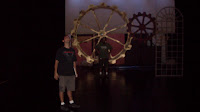
Song and dance in live performances can be traced back to ancient Greek and Roman cultures. Originally found in Grecian theatre, dance can be dated as far back as 240 BC.

Ancient Roman theaters were huge and seated thousands of people. Due to the extreme number of audience members, keeping a performance exciting was vital for audience approval. If the audience was not impressed they would throw items and heckle performers. In an effort to continually improve audience approval the Romans adopted dance including it in their wild performances, to help add a further element to the live shows.
Sound projection was also a problem a problem for the dancers as they had no
speaking parts so to draw the audience’s attention to their performance the dancers would nail metal to the bottom of their sandals to help make the dance steps louder. These would be considered the first tap shoes.
 There is an African expression that says: “If you can walk you can dance, if you can talk you can sing” As far back as can be traced, all cultures have sang and danced as a way to express their feelings, celebrate special events and pray. The medicine men of many cultures used dance as a form of prayer, asking the gods to bring rain, end famine and cure the sick. For this reason those medicine men are considered, by many, to be the first choreographers of formal dance.
There is an African expression that says: “If you can walk you can dance, if you can talk you can sing” As far back as can be traced, all cultures have sang and danced as a way to express their feelings, celebrate special events and pray. The medicine men of many cultures used dance as a form of prayer, asking the gods to bring rain, end famine and cure the sick. For this reason those medicine men are considered, by many, to be the first choreographers of formal dance.Dance and drama would not become fully integrated until the 20th century. In 1943 the musical "Oklahoma" opened in New York. Oklahoma was a huge success and truly invoked the combination of dance, music and drama as we know it today. The dances in Oklahoma were a big part of the story. Performed by students of ballet, this musical included folk, ballet and modern dance.
Equally as influential was the musical "Westside Story". Westside Story was first performed in New York in the 1950’s. One of the dance scenes between two rival street gangs serves as a great example of musical theatre dance, also known as character dance. Deep emotion is expressed in the dancing of this scene with strong meaning in every move.
This blog on dance in musicals would not be complete without mentioning a dance legend. Known not so much for his fancy footwork but for his great contribution as a choreographer, Bob Fosse's influence on dance in musical theatre can be seen in many musicals performed today. "Chicago" is an example of a musical, performed today, whose conventions mimic that of the "Chicago" directed and choreographed by Bob Fosse in 1975.
Born in Chicago the son of a burlesque show entertainer Bob Fosse grew up in and around burlesque style theatres. Burlesque style shows combine slapstick sketches, dirty jokes, and dance solos which included naked women. Influenced greatly by the old burlesque style Bob would go on to create award winning dance moves. His unique sexy ,shadow box style of choreography won him 9 Tony awards.
The following video is a performance from the Tony Award winning refue "Fosse". Enjoy
Work Cited
Felner, Mira, and Claudia Orenstein. The World of Theatre: Tradition and Innovation. Boston, MA: Allyn & Bacon, 2005.
"Great Performances . That's Dancin': Fosse on Broadway . "Chicago" PBS." PBS. 30 Oct. 2009
Kenrick, jJohn. "Dance in Stage Musicals." Musicals101.com - The Cyber Encyclopedia of Musicals. 28 Oct. 2009
"The History of Dance." Wendy Burke School of Dance. 28 Oct. 2009
"YouTube - Sing! Sing! Sing! (2 of 2) - Fosse." YouTube - Broadcast Yourself.. 28 Oct. 2009
Roman_theatre,_bosra,_syria,_easter_2004.jpg
madcodance.com














